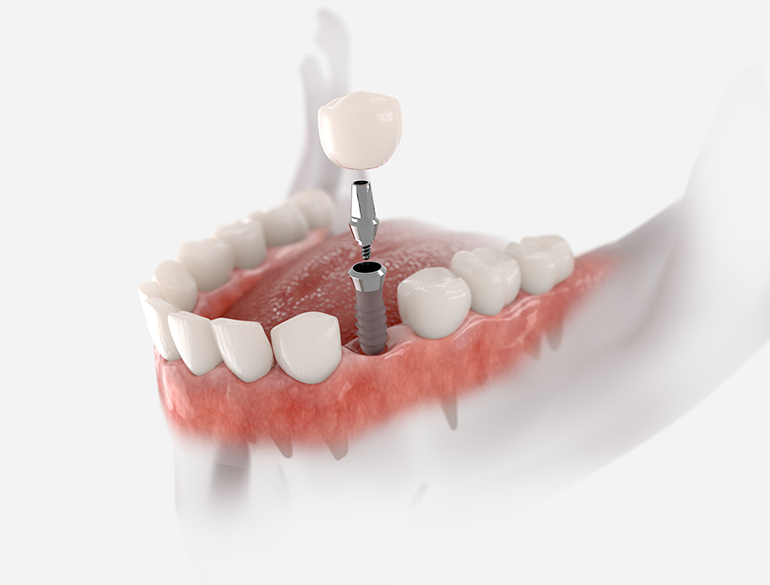Dental Sense Fundamentals Explained
Dental Sense Fundamentals Explained
Blog Article
Not known Incorrect Statements About Dental Sense
Table of ContentsExcitement About Dental SenseHow Dental Sense can Save You Time, Stress, and Money.A Biased View of Dental SenseThe 15-Second Trick For Dental Sense
are clinical devices surgically implanted right into the jaw to recover a person's ability to chew or their appearance. They provide support for man-made (phony) teeth, such as crowns, bridges, or dentures. When a tooth is shed because of injury or illness, a person can experience difficulties such as fast bone loss, malfunctioning speech, or changes to chewing patterns that result in pain.Dental implant systems include a dental implant body and oral implant joint and might likewise consist of a joint fixation screw. Dental implants. The dental implant body is surgically inserted in the jawbone in location of the tooth's root. The oral implant joint is typically attached to the dental implant body by the abutment addiction screw and extends with gums into the mouth to sustain the attached fabricated teeth
(https://dentalsense1.start.page)Structure of The Dental Implant System picking oral implants, speak with your dental provider concerning the possible advantages and dangers, and whether you are a prospect for the treatment. Points to think about: Your total health is a vital consider figuring out whether you are a great prospect for oral implants, how much time it will certainly require to recover, and the length of time the dental implant might stay in area.
Cigarette smoking may impact the healing procedure and reduce the lasting success of the dental implant. The healing procedure for the dental implant body might take several months or longer, during which time you commonly have a short-lived abutment in area of the tooth. the dental implant procedure: Meticulously follow the oral health instructions provided to you by your oral supplier.
The smart Trick of Dental Sense That Nobody is Talking About
Implant failing can cause the demand for an additional surgery to take care of or replace the implant system. Restores the ability to chew Brings back cosmetic appearance Aids maintain the jawbone from shrinking due to bone loss Protects the wellness of the surrounding bone and gum tissues Assists keep surrounding (nearby) teeth steady Improves top quality of life Damage to surrounding natural teeth during dental implant positioning Injury to the surrounding tissues throughout surgery, such as sinus opening Injury throughout surgical procedure (for instance, crack of bordering jawbone) Insufficient feature, such as feeling like the teeth do not attack with each other normally A sensation that the tooth is loosened or twisting in location resulting from a joint screw loosening up Implant body failure (looseness of the dental implant body) due to systemic infection, which may be more probable in clients with unchecked diabetics issues because of neighborhood infection in bone and gums sustaining the implant body because of postponed recovery, which may be a lot more most likely in people who smoke Trouble cleansing the periodontals around the implant, resulting in bad oral hygiene Without treatment gum condition Post-surgical tingling as a result of nerve impingement or damages Always notify healthcare service providers and imaging technicians that you have oral implants prior to any magnetic vibration imaging (MRI) or x-ray treatments.
FDA is not knowledgeable about any kind of damaging events reported for MRI or x-ray procedures with oral implants. Oral implants systems are usually made of materials that comply with worldwide agreement requirements of the International Company for Standardization (ISO) or ASTM International. These standards have details of what makes a risk-free product.

An oral implant is a structure that replaces a missing out on tooth. With screw-like devices, the cosmetic surgeon inserts an implant right into the jawbone, and it acts as a support for an artificial tooth, called a crown.
Some Known Questions About Dental Sense.
Some individuals are not qualified for dental implant surgical treatment. It is for oral doctors to operate individuals with: intense illnessuncontrollable metabolic diseasebone or soft tissue illness or infectionIf these issues are settled, an individual can have the surgical procedure. In, dental specialists avoid from running on individuals with: If individuals with any one of the above go through oral implant surgical procedure, there is a greater threat of the dental implant falling short.

Dental dental implant surgical treatment is an individualized procedure. It's not the same for every person. The complying with provides a general overview of what you can expect your dental professional, oral cosmetic surgeon, periodontist or prosthodontist to do: Place the implant surgically. Offer you time to recover. Attach the article and last crown, bridge or denture.
Next off, your cosmetic surgeon will carefully position the dental implant into your jaw. Your doctor will reposition your gum tissues and close the laceration with stitches. If your implant is near the front of your mouth, your dental expert will certainly make a short-lived tooth for you to use up until you recover. This way, you will not have a gap in your smile while you recoup.
Fascination About Dental Sense
Throughout the healing phase, your jawbone needs to fuse to the dental implant. This procedure can take anywhere from three to 9 months.
As soon as your implant heals, your dental practitioner can connect the abutment (tiny adapter post) and your final restoration (crown, bridge or denture). This normally takes concerning one hour to complete and may require a 2nd minor surgical procedure. You should not really feel any kind of pain throughout your oral implant treatment since your company will utilize drug to numb your gum tissues.
Report this page